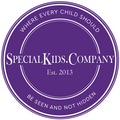
International Day of People with Disabilities
Did you know that Friday, 3rd December 2021 is the International Day of People with Disabilities? This day was sanctioned by the United Nations with the purpose of raising awareness of disability issues and the rights and well-being of those with disabilities.
This year, SpecialKids Company would like to mark the day by raising awareness of the many barriers to inclusion of children with special needs and their families encounter due to a lack of access and understanding.
Common barriers for lack of awareness for International Day of People With Disabilities
1. Attitudinal Barriers
Attitudinal barriers are common and usually caused by lack of awareness, understanding and ignorance. Some common examples include:
● Fear – some people are afraid of what they do not understand.
● Pity – often people can ‘feel sorry’ for disabled children, which can be extremely patronising.
● The Spread Effect – some people assume that a persons disability negatively impacts on their other abilities. A good example of this is someone speaking loudly to someone who is visually impaired.
● Inferiority – sometimes people with disabilities are treated as inferior to those who are not disabled.
These misconceptions can be extremely damaging and result in stigmatism and discrimination.
2. Environmental Barriers

Disabled children and their families face many environmental barriers as soon as they leave their house. Some examples include:
● A lack of Changing Places toilets – meaning that days out are cut short or that children are changed in unsafe, unhygienic and undignified places, like toilet floors.
● High curbs – make it difficult for children in wheelchairs or buggies to cross roads and access the pavement.
● Poor lighting – this can make life difficult for people with visual or neurological impairments.
● A lack of inclusive play park equipment – every child has the right to play, but many play parks are not fully inclusive meaning that lots of children with special needs are unable to access the equipment.
● Inaccessible communication systems – make it difficult for those with speech and language impairments to access places and learn.
These are just some examples, but they all create barriers to inclusion and participation.
3. Lack of Accessible Equipment

A lack of accessible equipment is a huge barrier to inclusion for many children with special needs. For example:
● Pool hoists – some children with mobility impairments are unable to access a swimming pool without a pool hoist. If there is no pool hoist, they are unable to access the swimming pool.
● Ceiling track hoists – ceiling track hoists transfer users safely across a room. These should be available in places such as GP surgeries, hospitals and hotel rooms but this is often not the case.
● Specialist sporting equipment – In order for some children with special needs to participate in sports, specialist equipment is required. For example, adapted wheelchairs and bikes.
● Mobility aids – sadly not all children with special needs have the mobility aids that they need. Specialist wheelchairs, buggies, walking aids are just some examples of equipment that can be hard to obtain.
4. Inadequate Funding
Unfortunately, often specialised products and services come with a ‘disability price tag’. This makes it hard for families to access what they need to make life easier for their child with special needs. Inadequate funding towards the disabled community and adaptations makes this especially difficult and can be a huge barrier to inclusion.
There are many more examples of barriers to inclusion that families with special needs children face. We hope that by raising awareness in time these barriers will be broken down.
Everyone should be valued and included.

